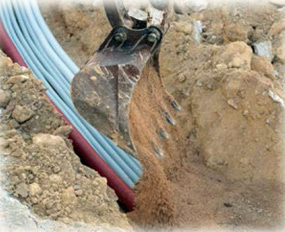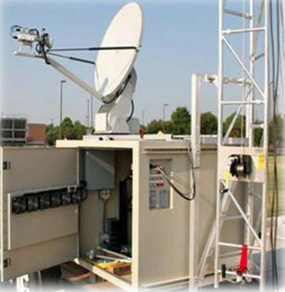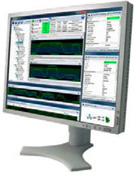Trunking circuits—the terrestrial fiber or submarine communications cables that transmit data within your core network—comes with the promise of enabling the delivery of voice and broadband…that is, until the link is cut.

The cut (break) can be unintentional, such as the result of a natural disaster or a construction company doing excavation. Or, the cut can be intentional, such as vandalism or corporate malicious conduct. Regardless of the cause, the result is the same…a breach in connectivity, which results in service interruption.
If you currently have, or are considering multi-site infrastructure restoral over satellite, read on for insight that could help you ensure cost-effective service continuity, so you can remain operational and profitable in the event of terrestrial communications failure.
Considerations, Complexities + Costs
Unfortunately, fiber/cable is often the weakest link in mobile networks. First, the sheer volume of traffic that is affected has an impact on a massive subscriber base. Its susceptibility to damage and interruption can negatively impact both service levels and revenue continuity for Mobile Network Operators (MNOs). Given your requirement for highly reliable core infrastructure and transport, MNOs like you are looking to satellite-based solutions for network infrastructure restoral.
Satellite provides the ideal solution given its resilience, flexibility and global, ubiquitous coverage. There are, however, a number of considerations, complexities and costs that must be evaluated when selecting a satellite-based solution that is cost-effective, efficient and able to deliver guaranteed service.
When establishing an infrastructure backup, the consideration should be as to how much satellite space segment is required. Should a network outage be encountered, sufficient bandwidth to restore services must be available. However, it can be cost prohibitive to provision backup satellite capacity for all sites at peak traffic levels.

Satellites are not affected by terrestrial events, and statistically not all sites will be affected by planned or unplanned events simultaneously. Therefore, the most cost-effective solution is an automated one that allows you to transfer traffic when there is an outage from cable to satellite. The ability should be present to consolidate and share services, to use the fewest amount of satellite resources, and to move resources around when and where needed.
There may be sites on multiple continents. Therefore, to properly provision satellite restoral service options, the need to deal with multiple transponders across an array of bandwidth segments and a range of satellite service providers will be evident. A solution is needed that can reduce operating costs throughout the year, but still provide the assurance of service for subscribers.
Another common challenge is not having co-located staff proficient in satellite. In the event of network failure, it may not be feasible or cost-effective to manually reconfigure and re-arrange satellite transponders and links for remote locations. A solution that doesn’t require on-site specialized resources should be in place.
There is an array of satellite-based communication options. While this will be your backup infrastructure, a solution that provides the highest performance possible and enables timely packet delivery and service differentiation is needed. As costs are a key consideration, the solution should leverage the latest bandwidth-saving technologies.
Automated, Flexible & Cost-Effective Restoral—A System Level Approach
Dimension Pool Capacity
Whether the satellite bandwidth is already leased, or is in the process of being obtained, how much capacity will be needed to support restoral services must be determined. There are many parameters that need to be considered, including satellite footprints, data rates, power requirements, and so on.

Comtech EF Data offers a mathematical method of determining the required capacity. Once all understand what is needed for 100 percent restoration, the probability of failure for each site is determined. From that point, numerous failure scenario iterations are run that target total network availability that suits a company’s needs.
Once the needed data rate network capacity is understood, link budgets and probability analysis are run to define the minimum bandwidth required to meet the target network availability. If an automated backup system and spectrally-efficient tools are used, significantly less satellite bandwidth will be required.

Proper dimensioning of bandwidth is largely based on pooling the bandwidth resources. When resources are shared in a pool, statistical probability can be used as an “oversubscription” model. In an ideal world, everyone would access the same pool of bandwidth by statistically aggregating the services and using (sharing) the same pool of bandwidth.
When selecting the right resources, satellites with footprints covering all or most of the sites are preferred. For maximum bandwidth pooling resources, as many of the sites must look at the same satellites as possible. Ideally, look for a single footprint with sufficient capacity that all of the sites can see. Focusing on the ever-present need to reduce OPEX, the ground equipment can then be sized to match the satellite footprint.

This may be one of the most important steps in establishing backup restoral services. If there are more than one terrestrial service that is to be aggregated, and the desire is to leverage a platform that can save bandwidth and OPEX, then allocate considerable time to the process of dimensioning pool capacity.
Locate Satellite Capacity
Which satellite operators, and specific facilities, should be contracted? How much bandwidth and power is needed? Identifying the best satellite resources can be a time-consuming and challenging task.
Comtech EF Data has a long-standing relationships with satellite operators globally as the company contacts span the operators’ headquarters, in-country facilities and teleports. By leveraging these contacts, the key contacts can be identified and the most suitable satellite capacity located.

Use Spectrally-Efficient Hardware
In order to best use the satellite capacity, infrastructure hardware is needed that provides maximum spectral efficiency. A significant amount of the company’s development resources are focused on creating patented and industry-leading technologies that provide unrivaled spectral efficiencies.
Comtech EF Data will work closely with a client to determine which of the tools and technologies are most suited for specific network and applications. The goal is to help identify the optimum products and tools for maximum spectral efficiency. Examples of technologies that are particularly useful for reducing the cost associated with satellite communications for infrastructure restoral are summarized below.
Vipersat Management System (VMS)—The VMS provides scalable, dynamic SCPC (dSCPC) capacity management that facilitates bandwidth sharing, automates space segment allocation and allows for establishment of efficient, low latency, low jitter links. It manages “pools” of available bandwidth and allows carriers to be setup, torn down and resized dynamically within the pools.
VMS dynamically finds and allocates capacity depending on how many circuits are down. There won’t be the need to contact satellite operators, manually adjust frequencies, power or symbol rates. After the appropriate amount of satellite capacity has been purchased, VMS will handle the satellite circuit configuration.
When there is a failure, VMS will find the appropriate space on the satellite, find the appropriate transponder, and put up the carrier. It is programmed to know if there is a failure, how much capacity is needed to transmit and receive. The power levels, symbol rates, modulation and coding are pre-programmed. When there is a failure, VMS looks at all of the available resources and determines where to put the circuit. The circuit is dimensioned and sized according to available transponders, essentially doing everything the operator would normally have to do. It actually manages the automation of putting a carrier up and tearing it down when you have an outage situation. The convenient GUI and network control also provides fault monitoring, event recording, and more.

DoubleTalk® Carrier-in-Carrier®—Based on patented “Adaptive Cancellation” technology, allows transmit and receive carriers of a duplex link to share the same transponder space. DoubleTalk Carrier-In-Carrier is complementary to all advances in modem technology, including advanced FEC and modulation techniques. It can enable the achievement of spectral efficiencies that cannot be achieved with traditional links. In simple terms, DoubleTalk Carrier-in-Carrier can be used to save transponder bandwidth and/or transponder power.
DVB-S2-EB1 (Efficiency Boost)—DVB-S2 is widely accepted as the most spectrally efficient standards-based waveforms. With the firm’s Efficiency Boost technology, a 10 to 35 percent increase in efficiency over the DVB-S2 standard can be achieved, without an increase in power or occupied bandwidth. This technology virtually doubles the number of available MODCODs compared to DVB-S2, which provides more throughput options to facilitate optimal combinations. DVB-S2-EB1 includes additional roll off figures (15, 10 and 5 percent) which translates into additional, incremental capacity.
Adaptive Coding & Modulation (ACM)—A statistical, non-static advantage that enables dynamic changes in user throughput. ACM doesn’t change the power or the bandwidth of the carrier, it just changes the MODCODs so more or less throughput can be obtained. Benefits and value vary over time and are not guaranteed, but are predictable. ACM essentially converts link margin to an increase in the data throughput of satellite links. When using ACM operation in the company’s products, link margin can be converted into increased throughput of satellite links.
WAN Optimization—Tools, such as the FX Series, will monitor all of the traffic that comes onto to the network and enables traffic shaping. Traffic shaping can be particularly useful for backup networks. In the event of a catastrophic failure, there may be a willingness to give up some of the services, such as data, to ensure that the essential voice and signaling services are available to users.

WAN optimization constantly monitors the WAN capacity, working in conjunction with satellite modems and VMS. In the case of a catastrophic event, the VMS will tell the circuits to shrink by a pre-determined amount so the failed sites can be fit into the network. The FX Series device understands that the WAN capacity has now shrunk.
Unfortunately, routers and MSC switches don’t understand changing capacities. The router or MSC switch feeds more traffic than the circuit can now handle. This is where the FX Series comes into play. It ingests all of the traffic, labels it, sorts it, and prioritizes it based on a variety of criteria or rules. Once the traffic has been filtered to put it into different priority classifications, it is drained, based on established rules. The result is a system that grabs less capacity than would normally be needed to backup the site with prioritization to ensure that the most important traffic is transmitted.
Integrated Network Management—the Comtech EF Data NetVue™ Integrated Management System is a powerful and scalable network management platform designed to seamlessly manage satellite networks. It provides a unified management interface to monitor, control, and obtain status for Comtech EF Data and other third-party products. The intuitive, web-based GUI presents the managed network in multiple views, providing real-time data gathering, trend analysis, alarm management and notification. It also offers advanced applications for automation, scheduling, event correlation, reporting, access via mobile devices and spectrum analysis. NetVue servers may be setup as stand-alone, in 1:1 redundant configuration or clustered in a manner that allows multiple locations to be part of a single cluster for redundancy and simplified user management and security.
NetVue’s flexibility and scalability make it an ideal management platform for small, medium and large networks. Its simplicity and ease of use enables operators to manage networks efficiently and cost effectively, to manage SLAs and to provide superior customer experiences.
Automate Capacity Usage
Once all of the tools are in place, there are various methods to automate the capacity usage. Here are a couple brief examples.
Semi-Automated / Manual Outage Restoral System—With this approach, the NOC personnel would be notified via call or alarm that one of the terrestrial cables is down and that backup services are required. The operator would use the M&C system (NetVue) to select which site is down and initiate the satellite backup link. This triggers the VMS to examine the available satellite capacity to find the best fit. VMS then puts up the circuit, tears down the old circuits, and so on. This is a simple process that just requires the operator to connect into the network management system for a matter of seconds.
Automated Outage Restoral System —Comtech EF Data’s M&C system (NetVue) can take commands and controls from other M&C systems or devices. Should there be a failure on a fiber/cable link, the site’s M&C system can see that the link has failed. The site’s M&C system sends a Machine-to-Machine message to our M&C system that indicates there is an outage at a specific site, and the backup capacity for that site will be brought up. Without any operator intervention, the satellite link will be established for the capacity needed by the site.
Scalability + Power
The more sites that need satellite restoration, the more aggregation can occur and a probability analysis completed. With multiple sites, the Comtech EF Data solution is scalable and powerful, enabling a small satellite bandwidth contract to be secured, and still have a completely automated backup for all of the terrestrial links at a network availability figure that customers expect.

About the author
Louis Dubin is Vice President of Product Management at Comtech EF Data. In this role, he is responsible for business development and product management of the high speed modems, TDMA modems, and broadcast products. Dubin joined Comtech EF Data in 2008, through the acquisition of Radyne Corporation. During his tenure at Radyne Corporation, he held the positions of President of Radyne’s Phoenix, Arizona division and Vice President of Sales. Dubin has over 20 years of experience in the telecommunications and transmission industry. He holds a degree in Electrical Engineering from the Florida Institute of Technology, and completed the Stanford Executive program in Technology Management.
* * * * * * * * *
Focus: The Vipersat Management System
The Vipersat Management System builds on years of providing our customers with the most advanced automated bandwidth and capacity management system in the industry. VMS is a feature-rich, comprehensive, intuitive operator’s network configuration, management, and control tool. The typical users include offshore Oil & Gas rig owners, satellite service providers, government/militaries/ministries, civil and aviation authorities, satellite newsgathering (SNG) operators, and cruise ship network administrators, to name but a few.
The system is designed to enable network administrators and satellite service providers to easily configure networks and rapidly and effectively respond to network anomalies. More than a network monitor and control platform, VMS automates the carrier switching and spectrum management processes within the satellite network. These capabilities allow SCPC carriers to be switched automatically based on application, load, or schedule, providing on-demand services and unparalleled space segment savings.

Key Benefits
Centralized satellite bandwidth management server / Operates over multiple transponders and satellites / True bandwidth-on-demand technology / Automation of satellite ground terminal transmission plans / Administratively-defined policies for transmission plan changes / Dynamic star and mesh satellite topologies / IP Layer 2, Layer 3, and hybrid networks supported / Total system redundancy / Scalable to address various network sizes
Dynamic Single Channel per Carrier (dSCPC)
Traditional Single Channel per Carrier satellite communication links do not change. As link budgets and network throughput requirements are based on the worst case scenario, these links are often underutilized.
With increasing satellite bandwidth costs combined with increasing throughput requirements, you are looking for the most efficient utilization of your operating budget. Dynamic Single Channel per Carrier provides increased efficiency in bandwidth utilization, carrier management, as well as personnel required to manage the network.
Altering a link typically requires substantial resources on both sides of the link. An analysis must be done to determine what new data rate the modem will require to be optimized for the network traffic load. A new link budget must be performed, including power calculations. A new frequency plan must be created, often requiring changes to multiple sites to accommodate the change. Finally, personnel must be located at both sides of every link involved simultaneously in order to reduce outage time. Leveraging dSCPC enables automation of the above.
When a node in the satellite network detects a change in the amount of throughput required via several automatic detection algorithms, it will automatically request that change from the VMS. The VMS will look at all satellite resource allocations and automatically determine a new frequency plan, power level, data rate, FEC, and modulation schemes for all modulators and demodulators involved in the change. All associated devices will simultaneously be sent these parameters over the air without human intervention. These calculations are done in fractions of a second with the entire process taking less than one second of total data loss in most cases.
dSCPC yields true bandwidth-on-demand, providing low-latency, low-jitter dedicated SCPC connections when needed for real-time applications, such as Voice over IP (VoIP), video conference, broadcasts and large applications (file or image transfers).
At any time, the operator has full manual override ability, and can turn on/off the auto-detection mechanisms.
In brief, there are three levels of service:
— Minimum Information Rate—A service level always available, ensuring the ability to enter a clear channel SCPC circuit or have a timeslot in STDMA.
— Committed Information Rate—Bandwidth that is guaranteed to be available instantaneously based on the demand or contention.
— Peak Information Rate—Bandwidth that can be used by any site on best effort availability, and categorized through multi-level prioritization.
Additional information on Vipersat is available at this direct link.

